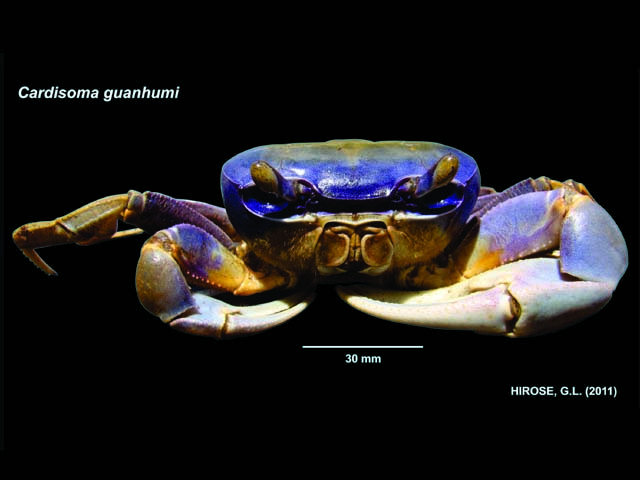| Gecarcinidae (land crabs) |
| 15 cm CW (male/unsexed) |
|
benthic; marine; depth range 0 - 2 m |
| Western Atlantic: From USA, the Gulf of Mexico, the Antilles, throughout the Caribbean and Brazil. |
|
Carapace broadly egg-shaped, narrow posteriorly and greatly inflated anterolaterally in adults; lateral margins not sharply defines; fronto-orbital distance (space between outer orbital angles) about 2/3 of maximum carapace width in adult males, nearly 3/4 in females. Pincers distinctly unequal, relatively smooth; fingers meeting only at tips, more gaping in larger hand, size of larger hand increasing disproportionately with age, especially in males. Walking legs sparsely hairy on margins, dactyls with 4 rows of spines. Color: juveniles dark brown; transitional stage dark purple and orange; adults lavender blue, females change to white or dull yellow at time of ovulation (once attained, color remains through autumn and winter in Florida population); males sometimes undergo less frequent and usually incomplete color changes. |
| Adults are terrestrial and can live as far as 5 miles away from the shore. They only return to the sea to drink and breed (Ref. 82656). Supratidal to intertidal (Ref. 97531). Nearly terrestrial species. Lives in great concentration in burrows (to 1.5 m deep) in relatively low lying ground, but also along canals or ditches among rocks and debris. Common in mangrove areas. Burrows may be as far as 8 km from the sea but always where the water table (fresh or salt) can be reached. Normally lives sub-aerially, occasionally wetting the gills, but can survive long periods of immersion and can adapt easily to great variations in water salinity. Females return briefly to the sea where eggs must hatch and larvae undergo developmental changes before transformation to the emergent crab stage. Feeds on a wide variety of plant material, occasionally some carrion. Cannibal (Ref. 367). Herbivore. Also an opportunistic feeder, consuming fiddler crabs, insects and carrion (Ref. 112918). Functionally an omnivore (Ref. 112923). |
|
Critically Endangered (CR) Ref. 123251)
|
|
|
Source and more info: www.sealifebase.org. For personal, classroom, and other internal use only. Not for publication.
Warning: Unknown: open(e:\temp\sess_gcagrpdoooue14hsdd9fdgj1p5, O_RDWR) failed: Permission denied (13) in Unknown on line 0
Warning: Unknown: Failed to write session data (files). Please verify that the current setting of session.save_path is correct (e:\temp) in Unknown on line 0

